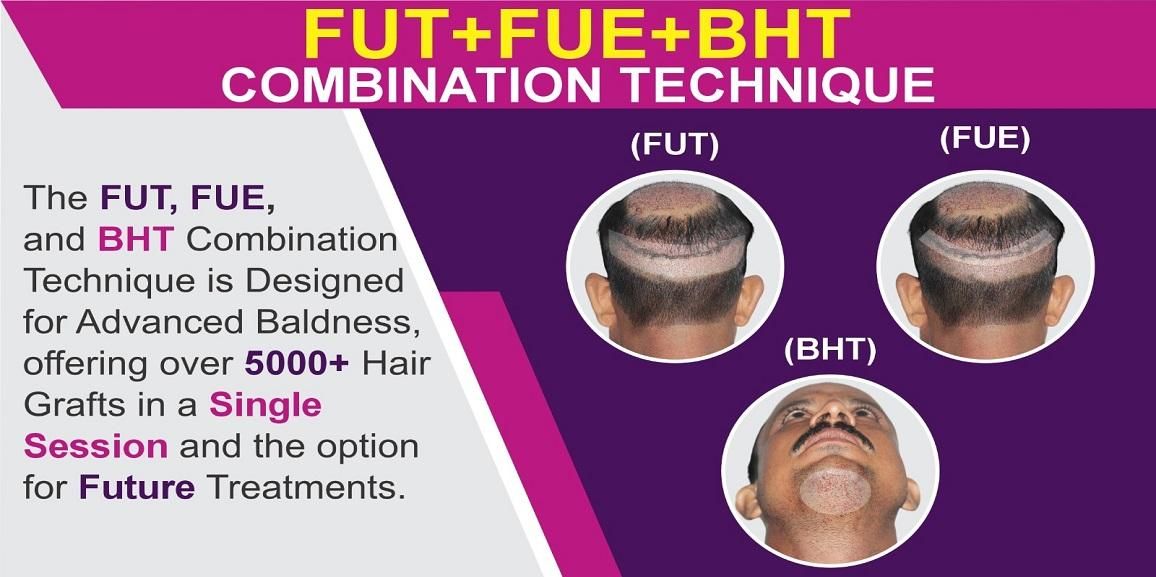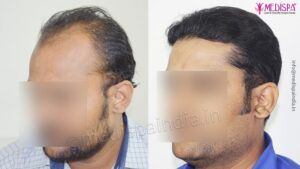
The subject of hair transplantation is continually undergoing advancements and breakthroughs. In the past, hair transplants were done with antiquated methods, which prevented the process from producing natural results. Instead, the bald region required numerous sessions to get a satisfactory level of hair density. Hair transplantation has advanced significantly in recent years, producing results that are both visually acceptable and as dense as feasible in a single session.
In circumstances of significant baldness, a number of cutting-edge treatments are currently used since they enable the operation to provide desirable outcomes in a single session. The novel methods that are employed are the FUT and FUE combination technique as well as the FUT, FUE, and BHT combination technique. Apart from harvesting a greater quantity of hair transplants, these approaches provide several additional advantages over the individual techniques in situations of profound baldness.
Can You Tell Me The Essentials of Hair Transplant?
A hair transplant involves surgically extracting hairs from permanent hair roots and transplanting them to the balding region. The recommended hair roots are those found at the back and side of the head since they are resistant to DHT hormone and do not thin when it is present, which is caused by genetic malfunction. Since the genetic makeup of hairs is found in the roots themselves rather than on the scalp, transplanting hair roots from DHT-resistant regions to bald areas results in permanent hair growth. Body hairs might potentially be chosen for harvesting if the hair follicles from the back and side of the head, the usual donor location, are insufficient.
Hair Transplant Techniques
Two fundamental contemporary hair transplant techniques are used, which are then modified and merged to create a novel process. The following explanation of the graft harvesting procedure serves as the basis for differentiating these two techniques:
- FUT hair transplantation, also known as strip method or follicular unit transplantation: This treatment involves taking a thin strip or segment of scalp skin from the back, side, or other regions of the body. In the graft separation chamber, this strip is further dissected to extract individual grafts surrounded by a sufficient number of tissues. The bald spot is then implanted with these individual hair grafts.
- FUE hair transplantation (Follicular unit extraction): This procedure involves utilizing a surgical instrument to remove a single hair graft from a secure donor location. The recipient location is then used for the transplantation of these hair grafts.
Transplant of Body Hair (BHT)
It is necessary to evaluate the available hair density at the safe donor area in order to verify the viability of hair transplantation for those experiencing hair loss. Body hairs are used as an option for collecting hair follicles if the hair density at the back and side of the head is insufficient. The process of extracting body hairs for the purpose of transplanting hair grafts to a desired recipient site is referred to as a “body hair transplant.”
Combination Technique of FUT, FUE, AND BHT
As we previously explained, when the scalp donor region is inadequate, BHT alone is an alternative to scalp harvesting. In order to increase advantages and provide a greater quantity of hair grafts, new advances have included the option of combining BHT with the combo method of FUT and FUE.
These days, high density hair transplants are highly sought after, and most patients have unrealistic expectations for the process. It becomes very hard to provide healthy hair density in the bald region in severe situations. However, because to developments in the field of hair transplantation, it is now somewhat feasible.
A recent development that offers a larger quantity of hair grafts while maintaining the donor site for subsequent sittings is the combination procedure of FUT+ FUE + BHT. This method performs the three hair transplant procedures—FUT, FUE, and BHT—in a single session. The goal of the FUT hair transplant process is to extract as many hair grafts as possible. The residual amount of hair grafts is harvested using FUE and BHT procedures.
Hair follicles from the beard region are extracted using the BHT procedure. The “shadow region” of the chosen beard is the area below the chin. Avoid touching other parts of the beard since there may be apparent scars.
The most recent armamentarium has made it feasible to extract grafts with nearly undetectable scarring. Very few amenities in India are using the newest, best equipment to carry out this treatment.
Hair transplantation with combination method at Medispa Clinic
Very few surgeons for hair transplant in India have a reputation for producing hair transplant results that are on par with the best in the world. They are considered to be among of the world’s top hair transplant surgeons. Even though patients can have their hair transplants performed by internationally recognized doctors, the hair transplant cost in India is incredibly low.
In order to improve the life of the hair grafts and ensure the permanence of the hair transplant results, we at Medispa Hair Transplant Clinic employ a holistic approach when choosing our techniques. At the Medispa Clinic, one of our most recent innovations is the performing the FUT, FUE, and BHT combination procedure. Hair transplants with FUE and FUT are completed in a single session.
In a single session, BHT is applied by extracting hair roots from the scalp, chest, beard, and most likely the pubic hair. Approximately 2800 hair grafts are extracted from the scalp using the FUT procedure, and 1200 are extracted using the FUE method. Approximately 500 hair transplants are taken from the pubic region, beard, and chest, among other body parts. We were able to harvest over 5000 hair transplants in a single session using this procedure. This method prevents overharvesting from any location while yet enabling a greater number of hair graft harvests. This makes the hair transplant results permanent and ensures that the hair transplant looks natural.





